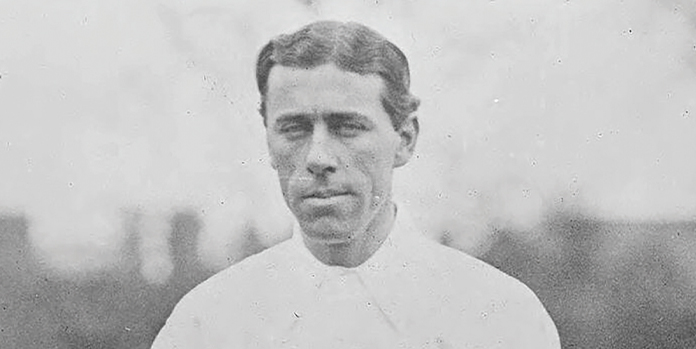Sir Norman Brookes (OM 1895) was a world champion tennis player many times over. However, people might be surprised to learn that his knighthood was awarded for an entirely different reason.
From promising player to international tennis icon
Entering Wadhurst in 1886—its first year, it was during his time at Melbourne Grammar School that Sir Norman’s potential as a tennis player first became clear, with wins in the Tennis Challenge Cup in both 1892 and 1893.
By 1907, he was the top tennis player in the world, having become the first Australian (and the first left hander) to win both the singles and doubles titles at Wimbledon that year. He repeated this achievement in 1914, and also took out the singles grand slam at the Australasian Championships—today’s Australian Open—in 1911.
Sir Norman came to be known as “The Wizard” and was particularly feared for his swerving left-handed serve and competitive nature, with his earnest on-court demeanour also being intimidating to many.
“Watching this stern-jawed, imperturbable […Brookes] on court, the onlooker might well get the impression that he never thaws—that life to him is a very serious occupation, trimmed with no frivolity or romance,” wrote a contemporary tennis writer. (Reports indicate that his committed and focused attitude carried into virtually all aspects of his life.)
With also 39 Davis Cup matches to his name, Sir Norman was honoured in both the Australian and International Tennis Halls of Fame in 1996 and 1985 respectively. He was inducted into the Sport Australia Hall of Fame in 1985.
His contributions as a player and committed tennis administrator are also remembered at the Australian Open with the men’s singles trophy being named the Norman Brookes Challenge Cup.
A replica of this trophy is presented to the winning First VIII rowing crew at the Head of the River each year, and one of his Wimbledon racquets is held in Melbourne Grammar School Archives.
Upon his death in 1968, Sir Norman was remembered by Prime Minister John Gorton, who wrote: “Sir Norman Brookes was one of those rare men who became a legend in their own lifetime. His name has been a household word synonymous with sporting achievement for as long as most Australians can remember.”
Five generations of service and connection
Beyond his impressive achievements on the tennis court, Sir Norman devoted much of his life to serving his community through both volunteer and appointed roles. Alongside his significant contributions to the life of Melbourne Grammar as President of The Old Melburnians and member of the School Council during 1933 and 1934, he also established a singular legacy in Australian tennis during his lifetime.
The determined dapper tennis player became the taciturn, sometimes tyrannical head of the game in Australia. But he remained a respected and admired figure in tennis and was knighted in 1939 for his services to the game.
Sir Norman was President of the Lawn Tennis Association of Victoria from 1925 until 1937 and it was largely due to his enterprise that Kooyong, purchased in 1919, was developed as a tennis centre.
He was also President of the Lawn Tennis Association of Australia (LTAA) for 29 years from 1926, shaping the game across the country and earning the informal title “the father of Australian tennis”.
But his service didn’t stop there. During WWI, Sir Norman was stationed in Egypt as commissioner of the Australian branch of the British Red Cross.
And even while he was devoted to advancing Australian tennis, Sir Norman also held several corporate leadership roles. By 1904 he was a director of Australian Paper Mills Co. Ltd, later becoming Chairman in 1921. He was also Chairman of North British and Mercantile Insurance Co. Ltd and a Director of several other companies.
The extended Brookes family tree now includes 24 members who have attended our School, with a fifth generation Norman Brookes descendant currently attending the School and another set to commence soon.
His brothers and their descendants have contributed to Melbourne Grammar in many important ways, from Alfred Brookes (OM 1936), who established Friends of Wadhurst—the group that would become Friends of Grammar—to Andrew Brookes (OM 1974), who served on the Old Melburnians Council, as backstage support for School productions for over 45 years, and is a current member of the Melbourne Grammar School Foundation Board.
In 2024, Wadhurst established Brookes House, recognising the Brookes family’s many generations of service to the School.
1907 – a year of achievement
When 29-year-old amateur tennis player Norman Brookes left Melbourne on 27 March 1907 bound for England on the RMS Moldavia, he could not have foreseen how significantly his life was about to change.
His plan was to play in the singles and doubles at Wimbledon – both of which he ultimately won, raising him to the standing of the top tennis player in the world. He also set out to represent Australasia at the Davis Cup to be played in England after the Wimbledon tournament and, again, he won along with the other member of the Australasia team, New Zealand champion, Anthony Wilding.
Travelling with his friend and informal tennis coach and former NSW tennis champion (and later best man at Sir Norman’s wedding in 1911), Dr Wilberforce Eaves, he finally arrived in London in the second week of May. The journey to London had taken around 45 days, and the cost was the equivalent of between $7,000AUD and $13,700AUD (in today’s currency) one way.
The journey wasn’t easy and it didn’t lend itself to training for the upcoming events – but Sir Norman did not let difficulties stand in his way.
At the time of departure Sir Norman declared that he intended to train vigorously, and that if the (Davis) cup was not secured for Australasia, it will not be for want of proper preparation and a strenuous fight.
Arriving in Fremantle on 8 April, Sir Norman and Eaves played an exhibition match on 9 April. He also played exhibition matches against Eaves in Colombo, Sri Lanka, and Fort Said, Egypt, during the trip, and a few practice games at the Queen’s Club, London, upon his arrival there.
It appears that he didn’t play competitively again until the All-England Tennis Championship (now known as Wimbledon) which was played from 24 June – 5 July. He won both the Men’s Singles Championship and the Doubles Championship with Wilding.
It was the first time since the Championships began in 1887 that the singles title passed out of the British Isles – that is, it was not won by an Englishman or Irishman.
Three representative teams played in the International Lawn Tennis Challenge (now known as the Davis Cup) that year – America, Great Britain and Australasia.
It was the third time Australasia had been represented in the competition but they had been defeated by America on each of the previous two occasions.
Together with, Wilding, they aimed to win. If they did so, it would mean that the following year, international teams would need to travel to Australia to compete for the Cup significantly raising the profile of tennis in Australia and Australia in tennis.
The tournament was played between 13 July – 24 July 1907 with, ultimately, Australia coming out on top.
In the end Sir Norman won every singles match he played in England from his arrival in May to the last ball of the Davis Cup on 23 July in 1907 – a remarkable achievement.



